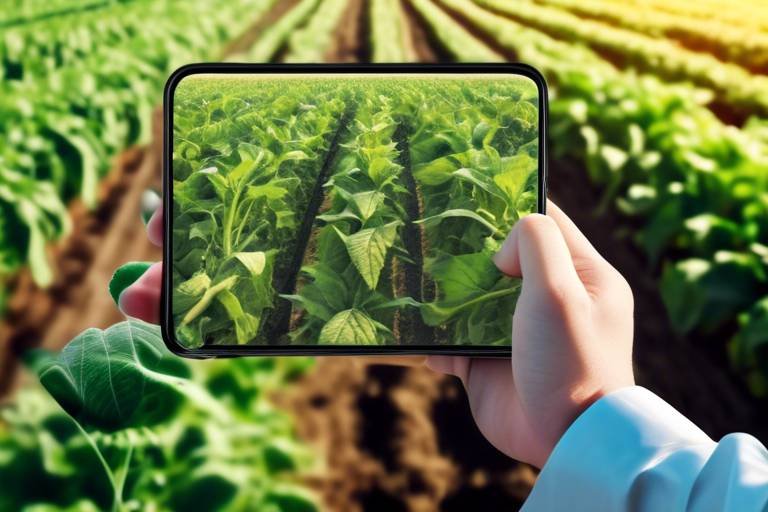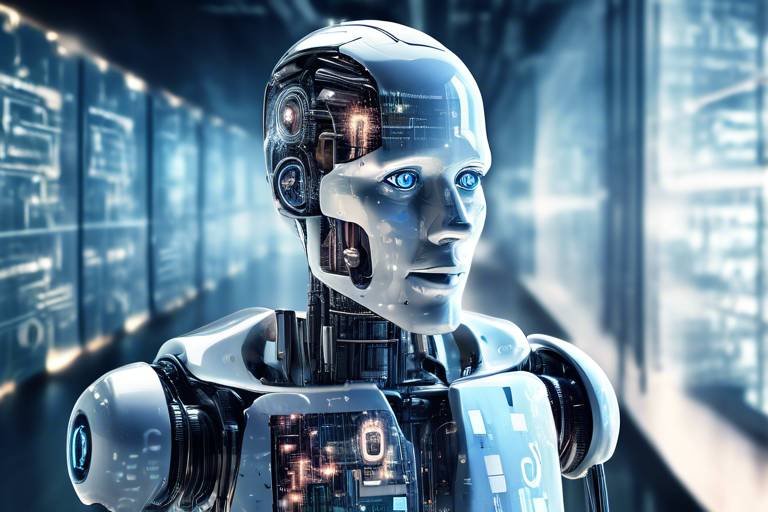The Fruitful Future of AI in Agriculture
The agricultural sector is on the brink of a revolution fueled by artificial intelligence (AI). As the world grapples with the challenges of a growing population, climate change, and dwindling natural resources, AI emerges as a beacon of hope. Imagine a future where farmers can predict crop yields with pinpoint accuracy, monitor plant health in real-time, and manage resources more efficiently than ever before. This is not just a dream—it's the fruitful future of AI in agriculture.
AI is transforming traditional farming practices into smart farming, where data-driven decisions lead to enhanced productivity and sustainability. By integrating AI technologies, farmers can optimize every aspect of their operations, from planting to harvest. The potential benefits are vast, ranging from increased crop yields to reduced environmental impact. As we delve deeper into the various applications of AI in agriculture, it becomes clear that this technology is not just a trend; it's a fundamental shift in how we approach food production.
Precision farming utilizes AI technologies to optimize field-level management regarding crop farming. Imagine being able to monitor your fields with the same precision as a surgeon operates in an operating room. AI helps farmers make data-driven decisions that can significantly increase yield while minimizing waste. By analyzing data from various sources, including satellite imagery, weather forecasts, and soil sensors, farmers can determine the optimal times for planting, watering, and fertilizing their crops.
With AI systems in place, constant monitoring of crops becomes a reality. These systems can identify diseases and pests at their inception, allowing farmers to intervene before significant damage occurs. Think of it as having a vigilant guardian watching over your crops, ready to act at the first sign of trouble. Early detection not only enhances crop health but also minimizes losses, ensuring that farmers can deliver high-quality produce to the market.
Automation in agriculture is revolutionizing traditional practices. From self-driving tractors to drones that monitor crop health, AI-driven machinery is improving efficiency and reducing labor costs. Picture a field where machines work tirelessly, planting seeds, watering crops, and harvesting produce without the need for constant human oversight. This not only saves time but also allows farmers to focus on strategic decision-making rather than mundane tasks.
Big data analytics, powered by AI, is changing the way farmers approach decision-making. By harnessing vast amounts of data, farmers can gain insights that lead to better resource management and crop planning. For instance, analyzing historical yield data alongside current market trends helps farmers decide which crops to plant for maximum profitability. It’s like having a crystal ball that provides clarity on the best paths to take in a complex and ever-changing environment.
Soil health is critical for sustainable agriculture. AI technologies can analyze soil conditions and recommend practices to improve fertility and structure. Imagine having a sophisticated lab in your pocket that tells you exactly what your soil needs to thrive. With AI, farmers can implement tailored soil management strategies that promote long-term sustainability, ensuring that the land remains productive for generations to come.
Efficient water usage is vital in agriculture. AI solutions are optimizing irrigation practices, ensuring crops receive the right amount of water while conserving resources. Consider a system that uses weather forecasts and soil moisture data to determine when and how much to irrigate. This not only saves water but also enhances crop health, leading to better yields and reduced costs. In a world where water scarcity is becoming a pressing concern, such innovations are essential.
AI is transforming agricultural supply chains by enhancing logistics and distribution. By analyzing data related to market demand, transportation routes, and storage conditions, AI can streamline operations, reduce waste, and improve market access for farmers. Imagine a scenario where farmers can predict market trends and adjust their production accordingly, minimizing surplus and maximizing profit. This level of efficiency can change the game for smallholder farmers, enabling them to compete in a global market.
The integration of AI in livestock farming is enhancing animal health and productivity. From monitoring feeding patterns to tracking health metrics, AI tools are supporting better management of livestock operations. Think of it as having a personal vet for each animal, capable of identifying health issues before they escalate. This leads to healthier livestock, increased productivity, and ultimately, a more sustainable farming operation.
As the world faces climate challenges, AI's role in promoting sustainable farming practices is crucial. Future trends indicate that AI will play an even larger role in developing resilient agricultural systems. Innovations such as vertical farming, genetically modified crops, and AI-driven resource management will shape the sustainability landscape. The question is not whether AI will be a part of agriculture's future, but how quickly it will be adopted to meet the demands of a growing population and a changing climate.
- What is precision farming? Precision farming is an agricultural management concept that uses technology to monitor and manage field variability in crops.
- How does AI help in crop monitoring? AI systems can analyze data from various sources to detect diseases and pests early, allowing for timely interventions.
- What are the benefits of automated farming equipment? Automated equipment can improve efficiency, reduce labor costs, and allow farmers to focus on more strategic tasks.
- Can AI improve soil health? Yes, AI can analyze soil conditions and recommend practices to enhance fertility and structure, promoting sustainable agriculture.
- How does AI optimize water usage in agriculture? AI uses data to determine the optimal times and amounts for irrigation, conserving water while ensuring crops receive necessary hydration.

AI-Powered Precision Farming
Imagine stepping into a field where every plant is monitored, every nutrient is accounted for, and every drop of water is used wisely. This is not a scene from a futuristic movie; it's the reality of . By leveraging cutting-edge technologies, farmers can now optimize their practices to achieve remarkable results. Precision farming utilizes AI to analyze data collected from various sources, such as satellite imagery, drones, and sensor networks, enabling farmers to make data-driven decisions that increase crop yields while minimizing waste.
At the heart of precision farming is the ability to gather and interpret vast amounts of data. Farmers can monitor soil moisture levels, temperature, and even the health of individual plants in real-time. This level of insight allows them to apply resources more efficiently, targeting specific areas that need attention rather than treating the entire field uniformly. For instance, if a particular section of a field shows signs of nutrient deficiency, farmers can apply fertilizers only to that area, thus saving costs and reducing environmental impact.
One of the most significant benefits of AI in precision farming is its capacity to forecast crop yields and optimize planting schedules. By analyzing historical data and current conditions, AI models can predict the best times for planting and harvesting, ensuring that farmers maximize their output. This predictive capability not only enhances productivity but also helps in resource management, allowing farmers to plan their operations around expected weather conditions and market demand.
Moreover, AI-powered precision farming can drastically reduce the use of pesticides and herbicides. By employing advanced algorithms to detect pest populations and disease outbreaks early, farmers can implement targeted interventions, applying treatments only when necessary. This approach not only protects the crops but also contributes to a healthier ecosystem. The result? A more sustainable farming practice that benefits both the farmer and the environment.
To better understand the impact of AI in precision farming, consider the following table that highlights key technologies and their benefits:
| Technology | Benefits |
|---|---|
| Drones | Provide aerial imagery for monitoring crop health, irrigation needs, and pest infestations. |
| Soil Sensors | Measure soil moisture and nutrient levels in real-time, enabling precise irrigation and fertilization. |
| AI Analytics | Analyze data trends to forecast yields and optimize planting schedules. |
As we delve deeper into the world of AI-powered precision farming, it becomes evident that this technology is not just a trend; it's a necessity for the future of agriculture. With the global population projected to reach 9.7 billion by 2050, the demand for food will only increase. By adopting AI-driven solutions, farmers can not only meet this demand but also do so in a way that is sustainable and environmentally friendly.
In conclusion, AI-powered precision farming is transforming the agricultural landscape. By embracing these technologies, farmers are not only enhancing their productivity but are also paving the way for a more sustainable future in food production. The journey towards smarter farming has begun, and the possibilities are endless.
Q1: How does AI improve crop yield?
AI improves crop yield by analyzing data from various sources to optimize planting, irrigation, and fertilization practices, ensuring that crops receive the exact care they need.
Q2: What are the main technologies used in precision farming?
Key technologies include drones for aerial monitoring, soil sensors for real-time data collection, and AI analytics for data interpretation and decision-making.
Q3: Is precision farming cost-effective?
Yes, precision farming can be cost-effective as it reduces waste, optimizes resource use, and ultimately leads to higher crop yields.

Crop Monitoring and Disease Detection
The agricultural landscape is rapidly evolving, and one of the most exciting advancements is the integration of artificial intelligence (AI) in crop monitoring and disease detection. Imagine walking through a field where every leaf, every stem, and every root is under constant surveillance—this is the reality that AI brings to modern farming. By utilizing machine learning algorithms and data analytics, farmers can now detect diseases and pests before they wreak havoc on their crops, ensuring healthier yields and minimizing losses.
AI systems equipped with remote sensing technology can analyze images captured by drones or satellites, providing real-time insights into crop health. These systems can identify subtle changes in color, texture, and growth patterns that may indicate the presence of disease or pest infestations. For instance, a slight yellowing of leaves could signal nutrient deficiencies or the onset of a fungal infection. By catching these issues early on, farmers can implement targeted interventions that are both cost-effective and environmentally friendly.
Furthermore, the ability of AI to process vast amounts of data allows for the creation of predictive models that forecast potential outbreaks. This means that farmers can take a proactive approach to crop management rather than merely reacting to problems as they arise. Imagine the power of knowing that a particular pest is likely to invade your field next week—farmers can prepare in advance, applying treatments only where and when necessary, which not only saves money but also reduces the use of harmful chemicals.
To illustrate the impact of AI in crop monitoring, consider the following table that summarizes the benefits of AI-driven disease detection:
| Benefit | Description |
|---|---|
| Early Detection | Identifies diseases and pests before they spread, allowing for timely intervention. |
| Data-Driven Decisions | Utilizes analytics to guide farmers in making informed choices about crop management. |
| Resource Efficiency | Reduces the need for broad-spectrum pesticides by targeting treatments. |
| Increased Yields | Enhances overall crop health, leading to higher productivity and profitability. |
Moreover, the integration of AI in crop monitoring fosters a deeper understanding of the agricultural ecosystem. Farmers can monitor not just their crops but also the environmental factors that influence them, such as soil moisture levels, temperature fluctuations, and even weather patterns. This holistic view enables farmers to cultivate their fields with a level of precision that was previously unimaginable.
In conclusion, the role of AI in crop monitoring and disease detection is not just a trend—it’s a transformative force that empowers farmers to optimize their practices and enhance sustainability. As we embrace these technologies, we pave the way for a future where agriculture is not only more productive but also more resilient against the challenges posed by climate change and a growing global population.
- How does AI detect crop diseases? AI uses image recognition and data analysis from drones and sensors to identify early signs of disease.
- What are the benefits of using AI in agriculture? Benefits include early detection of issues, reduced pesticide use, and improved crop yields.
- Can AI predict pest outbreaks? Yes, AI can analyze historical data and environmental conditions to forecast potential pest invasions.
- Is AI technology expensive for farmers? While initial costs may be high, the long-term savings and increased yields often outweigh the investment.

Automated Farming Equipment
The world of agriculture is undergoing a remarkable transformation, thanks to the advent of . Imagine a farm where machines do the heavy lifting, allowing farmers to focus on strategy and sustainability rather than labor-intensive tasks. This is not just a dream; it's becoming a reality through the integration of artificial intelligence (AI) in farming tools and machinery. Automated farming equipment, such as drones, robotic harvesters, and smart tractors, are revolutionizing the way we cultivate crops and manage agricultural operations.
One of the most exciting aspects of automated farming is its ability to enhance efficiency and reduce operational costs. Traditional farming methods often rely on manual labor, which can be both time-consuming and expensive. However, with AI-powered machines, farmers can achieve more in less time. For instance, robotic harvesters can work around the clock, picking fruits and vegetables at peak ripeness, ensuring that nothing goes to waste. This not only maximizes yield but also improves the quality of the produce.
Drones have also emerged as game changers in the agricultural landscape. Equipped with advanced sensors and imaging technology, they can survey vast areas of farmland in a fraction of the time it would take a human. These drones collect data on crop health, soil conditions, and even moisture levels, providing farmers with real-time insights that are crucial for making informed decisions. Imagine being able to identify a pest infestation or nutrient deficiency before it becomes a significant problem! The ability to act quickly can save farmers from potential losses and ensure a thriving crop.
The integration of AI into automated farming equipment doesn't stop at just harvesting and monitoring. Smart tractors, for example, come equipped with GPS technology and AI algorithms that allow them to navigate fields autonomously. This means they can plow, seed, and fertilize with pinpoint accuracy, minimizing waste and maximizing efficiency. By reducing overlaps and ensuring even distribution of seeds and fertilizers, these machines not only save resources but also promote healthier crop growth.
The benefits of automated farming equipment extend beyond just productivity; they also contribute to sustainability. By optimizing resource usage and minimizing the environmental impact, farmers can adopt practices that are better for the planet. For instance, precision irrigation systems powered by AI can adjust water supply based on real-time weather data and soil moisture levels, ensuring that crops receive the right amount of water without wasting a drop. This not only conserves water but also reduces energy consumption associated with irrigation.
In conclusion, the rise of automated farming equipment signifies a new era in agriculture. With the help of AI, farmers are equipped with tools that enhance their productivity, reduce costs, and promote sustainable practices. As technology continues to evolve, we can expect even more innovative solutions that will further transform the agricultural landscape. The future of farming is not just about growing more food; it's about growing it smarter and more sustainably.
Frequently Asked Questions
- What types of automated farming equipment are available?
There are various types of automated farming equipment, including robotic harvesters, drones for crop monitoring, smart tractors, and precision irrigation systems.
- How does automated farming equipment improve efficiency?
Automated equipment can perform tasks faster and with greater accuracy than manual labor, reducing the time and resources needed for farming operations.
- Is automated farming equipment environmentally friendly?
Yes, many automated systems are designed to optimize resource use, such as water and fertilizers, which helps to minimize waste and reduce environmental impact.
- Can small farms benefit from automated farming equipment?
Absolutely! There are scalable solutions available that can help small farms increase productivity and efficiency without requiring significant investments.

Data Analytics for Improved Decision Making
In the ever-evolving world of agriculture, the ability to make informed decisions is more critical than ever. Data analytics, powered by artificial intelligence, is transforming how farmers approach their daily operations. Imagine having a crystal ball that not only predicts the weather but also analyzes soil conditions, crop health, and market trends. This is the kind of power that AI brings to the table, allowing farmers to make data-driven decisions that can significantly enhance productivity and profitability.
Farmers today are inundated with data from various sources—satellite imagery, sensor data from fields, weather forecasts, and market prices. The challenge lies in sifting through this vast amount of information to extract actionable insights. This is where AI and data analytics come into play. By leveraging machine learning algorithms, farmers can analyze historical data and identify patterns that were previously invisible. For instance, AI can predict the optimal planting times based on weather patterns and soil moisture levels, ultimately leading to higher yields.
Moreover, data analytics can help farmers optimize resource allocation. With the right insights, they can determine the precise amount of fertilizers and pesticides needed, reducing waste and minimizing environmental impact. This not only saves money but also supports more sustainable farming practices. A study conducted by the Food and Agriculture Organization (FAO) found that farmers who utilized AI-driven analytics saw a 15-20% increase in crop yields while simultaneously reducing input costs.
Another significant advantage of data analytics is its ability to enhance crop planning. By analyzing market trends and consumer preferences, farmers can make informed decisions about which crops to plant and when to sell them. This proactive approach helps in avoiding market saturation and ensures that farmers can maximize their profits. For example, if data indicates a rising demand for organic produce, a farmer can adjust their planting schedule accordingly to capitalize on this trend.
To illustrate the impact of data analytics on decision-making in agriculture, consider the following table:
| Data Type | Benefit | Impact on Decision Making |
|---|---|---|
| Weather Data | Predicts optimal planting and harvesting times | Increases yield and reduces losses |
| Soil Health Data | Identifies nutrient deficiencies | Optimizes fertilizer application |
| Market Trends | Informs crop selection | Maximizes profits and reduces waste |
As we look to the future, the integration of data analytics in agriculture is set to expand even further. The advent of Internet of Things (IoT) devices will enable real-time data collection from fields, allowing farmers to respond to changing conditions instantly. Imagine a scenario where a farmer receives an alert on their smartphone about a potential pest outbreak based on sensor data, enabling them to take immediate action before significant damage occurs.
In conclusion, the role of data analytics in agriculture cannot be overstated. It empowers farmers to make informed decisions that enhance productivity, reduce costs, and promote sustainability. As technology continues to advance, we can expect even more innovative solutions that will further transform the agricultural landscape, making it more efficient and resilient in the face of global challenges.
- What is data analytics in agriculture? Data analytics in agriculture refers to the use of data analysis techniques to gather insights from various agricultural data sources, helping farmers make better decisions.
- How does AI improve decision-making in farming? AI analyzes large datasets to identify patterns and trends, enabling farmers to make data-driven decisions that enhance productivity and profitability.
- Can data analytics help reduce costs in farming? Yes, by optimizing resource allocation and minimizing waste, data analytics can significantly lower operational costs for farmers.

Enhancing Soil Health with AI
Soil health is the foundation of sustainable agriculture, and with the rapid advancements in technology, artificial intelligence (AI) is emerging as a game-changer. Imagine walking through a lush green field, where every inch of soil is monitored and optimized for maximum productivity. This is the future that AI promises, allowing farmers to understand their soil like never before. By leveraging AI technologies, farmers can analyze soil conditions, identify nutrient deficiencies, and recommend precise practices to enhance fertility and structure. It's akin to having a personal soil doctor who provides tailored advice based on real-time data.
One of the primary benefits of using AI in soil health management is its ability to process vast amounts of data from various sources. Sensors placed in the field can collect information about moisture levels, pH balance, and nutrient content. This data is then analyzed using sophisticated algorithms that can predict how these factors influence crop growth. For example, if the AI detects that a specific area of soil is lacking in nitrogen, it can recommend targeted fertilization strategies that not only boost crop yield but also minimize environmental impact.
Furthermore, AI can help in implementing precision agriculture practices that focus on the specific needs of different areas within a farm. Traditional farming methods often treat fields uniformly, which can lead to over-fertilization in some areas and under-fertilization in others. AI-driven solutions enable farmers to create site-specific management plans that optimize inputs based on the unique characteristics of each zone. This not only enhances soil health but also promotes sustainable practices by reducing chemical runoff and preserving biodiversity.
Another fascinating aspect of AI in soil health enhancement is its ability to predict future soil conditions. By analyzing historical data and current trends, AI can forecast potential challenges such as erosion or nutrient depletion. This proactive approach allows farmers to take preventive measures before problems escalate. For instance, if the AI predicts that a certain area is at risk of erosion due to heavy rainfall, farmers can implement soil conservation techniques in advance, safeguarding their crops and the soil structure.
To illustrate the impact of AI on soil health, consider the following table that summarizes key benefits:
| Benefit | Description |
|---|---|
| Data-Driven Insights | AI analyzes soil data to provide actionable insights for better management. |
| Targeted Fertilization | Recommends specific nutrient applications based on real-time analysis. |
| Predictive Analytics | Forecasts future soil conditions to help prevent issues before they arise. |
| Environmental Sustainability | Reduces chemical use and promotes biodiversity through optimized practices. |
In conclusion, the integration of AI in enhancing soil health is not just a trend; it's a necessary evolution in agriculture. As we face the challenges of a growing global population and climate change, utilizing AI to maintain and improve soil quality will be crucial for sustainable farming. Farmers equipped with AI tools can make informed decisions that benefit their crops, the environment, and ultimately, our food systems.

Water Management Innovations
Water management is one of the most critical aspects of agriculture, especially as climate change continues to affect weather patterns and water availability. Farmers are increasingly turning to artificial intelligence (AI) to revolutionize how they manage water resources. Imagine a world where irrigation systems can predict weather changes and adjust watering schedules accordingly—this is not just a dream but a reality made possible by AI technologies. With advanced algorithms and real-time data collection, AI can help farmers ensure that their crops receive the right amount of water at the right time, significantly enhancing productivity while conserving precious water resources.
One of the key innovations in water management is the development of smart irrigation systems. These systems utilize sensors placed in the soil to monitor moisture levels continuously. When the soil becomes too dry, the system automatically activates the irrigation process, delivering just the right amount of water needed for optimal growth. This not only reduces water wastage but also helps in maintaining the soil's health. By using AI to analyze historical weather data, these systems can predict when rainfall is likely, allowing farmers to adjust their irrigation schedules accordingly. The result? A more sustainable approach to farming that aligns with nature rather than working against it.
Furthermore, AI-powered tools can analyze various factors affecting water usage, such as crop type, growth stage, and local climatic conditions. This data-driven approach enables farmers to create customized irrigation plans tailored to their specific needs. For instance, a farmer growing tomatoes might require different watering schedules compared to someone cultivating corn. With AI, farmers can easily optimize their water management strategies, leading to increased crop yields and reduced costs.
To illustrate the impact of AI in water management, consider the following table that compares traditional irrigation methods with AI-driven smart irrigation systems:
| Aspect | Traditional Irrigation | AI-Driven Smart Irrigation |
|---|---|---|
| Water Efficiency | Low | High |
| Labor Requirement | High | Low |
| Adaptability to Weather Changes | Limited | Dynamic |
| Cost Over Time | Higher due to waste | Lower with optimized usage |
Moreover, AI can also play a significant role in drainage management. Excess water can lead to soil erosion, nutrient leaching, and crop damage. AI systems can analyze rainfall data and soil saturation levels to determine the best times for drainage, ensuring that fields remain healthy and productive. By preventing waterlogging, farmers can protect their crops and improve their overall yield.
In conclusion, the integration of AI in water management is not just a trend; it’s a necessary evolution in farming practices. As we face increasing environmental challenges, the ability to manage water resources efficiently will become crucial. With smart irrigation systems, data-driven insights, and automated drainage management, farmers can cultivate their crops more sustainably and effectively. The future of agriculture is undoubtedly intertwined with the innovations brought forth by AI, and water management is at the forefront of this transformation.
- How does AI improve water management in agriculture?
AI enhances water management by providing real-time data analysis and automating irrigation schedules based on soil moisture levels and weather predictions. - What are smart irrigation systems?
Smart irrigation systems use sensors and AI algorithms to optimize water usage, ensuring crops receive the right amount of water while minimizing waste. - Can AI help in drought conditions?
Yes, AI can analyze water usage and crop needs, allowing farmers to conserve water more effectively during droughts.

Supply Chain Optimization
In the ever-evolving world of agriculture, has become a game-changer, thanks to the integration of artificial intelligence (AI). Imagine a bustling marketplace where farmers, suppliers, and consumers are interconnected like a finely-tuned orchestra, each playing their part in harmony. AI technologies are stepping onto this stage, conducting the symphony of agricultural logistics and distribution. By harnessing the power of AI, farmers can streamline operations, reduce waste, and improve market access, ultimately leading to a more efficient and sustainable food system.
AI-driven supply chain solutions can analyze vast amounts of data, from crop yields to market demand, allowing farmers to make informed decisions that optimize their production and distribution processes. For instance, AI can predict when crops will be ready for harvest and suggest the best times for transportation, minimizing delays and spoilage. This kind of data-driven approach not only enhances efficiency but also helps in managing costs effectively.
Moreover, AI can facilitate better communication between various stakeholders in the supply chain. By utilizing real-time data analytics, farmers can share insights with distributors and retailers, ensuring that everyone is on the same page. This transparency leads to a reduction in overproduction and waste, as everyone involved can adjust their strategies based on current market conditions. For example, if a certain crop is in high demand, farmers can ramp up production, while those with excess inventory can find alternative markets or adjust prices accordingly.
To illustrate the impact of AI on supply chain optimization, consider the following table that highlights key benefits:
| Benefit | Description |
|---|---|
| Reduced Waste | AI helps in predicting demand accurately, reducing overproduction and spoilage. |
| Cost Efficiency | Optimized logistics lead to lower transportation and storage costs. |
| Improved Forecasting | Data-driven insights allow for better planning and resource allocation. |
| Enhanced Collaboration | Real-time data sharing fosters better relationships among supply chain partners. |
Furthermore, AI can revolutionize inventory management. By employing machine learning algorithms, farmers can monitor stock levels and predict when to reorder supplies. This proactive approach ensures that they never run out of essential resources, which can be critical during peak planting or harvesting seasons. In this way, AI acts like a vigilant guardian, always watching over the supply chain to ensure everything runs smoothly.
As we look to the future, it’s clear that the role of AI in supply chain optimization will only grow. With the increasing pressures of climate change and a rising global population, efficient supply chains are more important than ever. By leveraging AI technologies, farmers can not only enhance their operational efficiency but also contribute to a more sustainable agricultural ecosystem. The integration of AI in supply chain management is not just a trend; it is a necessary evolution in the way we produce and distribute food.
- How does AI improve supply chain efficiency in agriculture?
AI analyzes data to optimize logistics and distribution, helping farmers make informed decisions that reduce waste and improve market access. - What role does data play in AI-driven supply chain optimization?
Data is crucial for predicting demand, managing inventory, and enhancing communication among supply chain partners. - Can AI help reduce food waste?
Yes, AI can predict crop yields and market demand, allowing farmers to adjust production and minimize spoilage.

AI in Livestock Management
When you think of agriculture, your mind might wander to vast fields of crops swaying in the breeze, but let's not forget about the unsung heroes of the farming world: livestock. The integration of artificial intelligence (AI) in livestock management is transforming how farmers care for and manage their animals. Imagine a world where farmers can monitor the health and well-being of their livestock at the touch of a button, ensuring that each animal receives personalized care. This is not just a dream; it’s becoming a reality thanks to AI technologies.
AI is revolutionizing livestock management in a multitude of ways. For instance, advanced monitoring systems equipped with sensors and cameras can track the behavior and health of animals in real-time. These systems analyze data to detect early signs of illness or distress, allowing farmers to intervene before a minor issue becomes a major problem. This proactive approach not only enhances animal welfare but also significantly reduces the costs associated with veterinary care and medication. Wouldn't you agree that prevention is better than cure?
Moreover, AI-driven tools can optimize feeding practices. By analyzing data on each animal's growth patterns and nutritional needs, farmers can tailor diets to maximize productivity. For example, a farmer can use an AI system to determine the optimal feed mix for a group of cattle, ensuring they receive the right nutrients at the right time. This not only boosts growth rates but also minimizes feed waste, making the entire operation more sustainable.
In addition to health monitoring and feeding optimization, AI is enhancing breeding programs. Through genetic analysis and predictive modeling, farmers can identify the best candidates for breeding, ensuring that desirable traits are passed on to future generations. This kind of data-driven decision-making can lead to stronger, healthier livestock that are better suited to thrive in changing environmental conditions.
However, the benefits of AI in livestock management extend beyond the farm itself. By utilizing AI technologies, farmers can improve their record-keeping and compliance with regulations. For instance, AI can help track vaccination schedules, breeding dates, and overall animal health records, making it easier for farmers to meet industry standards and maintain certifications. This kind of transparency not only builds trust with consumers but also opens up new market opportunities.
As we look to the future, the role of AI in livestock management is only expected to grow. In the next few years, we might see even more sophisticated systems that incorporate machine learning and predictive analytics. These advancements could lead to more efficient resource use, enhanced animal welfare, and ultimately, a more productive and sustainable livestock industry.
In conclusion, the integration of AI in livestock management is not just a trend; it is a necessary evolution in the agricultural sector. By embracing these technologies, farmers can ensure their livestock are healthy, productive, and well-cared for, paving the way for a more sustainable future in farming.
- How does AI improve livestock health monitoring?
AI systems can analyze data from sensors to detect signs of illness early, allowing for timely interventions. - Can AI help with feeding livestock?
Yes, AI can optimize feeding practices by analyzing individual animal needs and growth patterns. - What are the benefits of using AI in breeding programs?
AI helps identify the best breeding candidates based on genetic analysis, leading to healthier offspring. - Is AI in livestock management cost-effective?
Absolutely! By reducing veterinary costs and optimizing feed usage, AI can lead to significant savings.

The Future of AI in Sustainable Agriculture
The future of AI in sustainable agriculture is not just a concept; it’s a vibrant reality that’s unfolding before our eyes. As the world grapples with escalating climate challenges, the integration of artificial intelligence into farming practices is proving to be a game-changer. Imagine a world where farmers can predict weather patterns, monitor soil health in real-time, and optimize their resource usage—all at the touch of a button. This is the promise of AI, and it’s already beginning to reshape the agricultural landscape.
One of the most exciting aspects of AI in sustainable agriculture is its ability to enhance resource efficiency. With the help of machine learning algorithms and predictive analytics, farmers can make informed decisions about when to plant, irrigate, and harvest crops. This not only maximizes yield but also minimizes the use of water, fertilizers, and pesticides—elements that can significantly impact the environment if used excessively. For instance, AI can analyze weather data and soil conditions to determine the optimal time for planting, ensuring crops receive the right amount of nutrients and moisture.
Moreover, AI plays a crucial role in improving biodiversity and promoting ecological balance. By utilizing AI-driven tools, farmers can monitor the health of various species within their ecosystems. This allows them to implement practices that support biodiversity, such as rotating crops and integrating cover crops, which can enhance soil fertility and reduce erosion. The result? A more resilient agricultural system that can withstand the pressures of climate change.
In addition to enhancing crop production, AI is also revolutionizing the way we approach livestock management. Advanced AI systems can track the health and well-being of animals, providing farmers with insights into their dietary needs, breeding cycles, and overall health. This not only leads to healthier livestock but also reduces the need for antibiotics and other medications, promoting a more sustainable approach to animal husbandry.
As we look towards the future, the potential for AI in sustainable agriculture is vast. Innovations such as autonomous drones for crop monitoring, AI-powered robots for planting and harvesting, and smart irrigation systems are just the tip of the iceberg. These technologies are not merely tools; they represent a shift towards a more sustainable and efficient agricultural paradigm. Farmers who embrace these technologies will not only improve their productivity but also contribute to a healthier planet.
However, the journey towards sustainable agriculture with AI is not without challenges. Issues such as data privacy, the digital divide between urban and rural areas, and the need for farmer education and training must be addressed to fully realize the benefits of AI in agriculture. Collaborative efforts among governments, tech companies, and agricultural organizations will be essential to create an ecosystem that supports innovation while ensuring that all farmers, regardless of their resources, can participate in this agricultural revolution.
In conclusion, the future of AI in sustainable agriculture is bright and full of possibilities. As we continue to innovate and adapt, the synergy between technology and farming practices will pave the way for a more sustainable, efficient, and productive agricultural sector. The question is not whether AI will play a role in agriculture, but rather how quickly we can harness its potential to create a better future for farmers and our planet.
- How does AI improve crop yield? AI analyzes data from various sources to help farmers make informed decisions about planting, irrigation, and fertilization, ultimately leading to higher yields.
- What are the environmental benefits of AI in agriculture? By optimizing resource use and reducing waste, AI helps minimize the environmental impact of farming practices, promoting sustainability.
- Can AI help with livestock management? Yes, AI technologies can monitor the health and productivity of livestock, leading to better management practices and healthier animals.
- What challenges does AI face in agriculture? Challenges include data privacy concerns, the digital divide, and the need for farmer education and training to effectively use AI technologies.
Frequently Asked Questions
- What is AI-powered precision farming?
AI-powered precision farming utilizes advanced technologies to enhance field-level management in crop farming. By analyzing data from various sources, farmers can make informed decisions that boost yield while minimizing waste. Imagine having a personal assistant that tells you exactly when to water your plants or apply fertilizers—now that's smart farming!
- How does AI help in crop monitoring and disease detection?
AI systems are like vigilant guardians for crops. They continuously monitor plant health and can detect diseases or pests at an early stage. This timely intervention can save a harvest from potential losses, ensuring that farmers can act swiftly. Think of it as having a health check-up for your crops—early detection leads to better outcomes!
- What are automated farming equipment and how do they work?
Automated farming equipment includes AI-driven machinery that performs various tasks in agriculture, from planting seeds to harvesting crops. These machines are designed to work efficiently, reducing labor costs and increasing productivity. It's akin to having a robot chef in your kitchen, doing all the heavy lifting while you focus on the final touches!
- How does data analytics improve decision-making in agriculture?
Data analytics powered by AI provides farmers with insights that were previously unimaginable. By analyzing large sets of data, farmers can optimize resource management and make better crop planning decisions. Picture it like having a crystal ball that shows you the best time to plant or harvest—talk about a game-changer!
- In what ways can AI enhance soil health?
AI technologies can analyze soil conditions, providing recommendations to improve fertility and structure. By understanding the nuances of soil health, farmers can implement practices that lead to sustainable agriculture. It's like getting a personal trainer for your soil, helping it reach its full potential!
- How does AI contribute to efficient water management in agriculture?
Efficient water usage is paramount in farming, and AI offers innovative solutions for optimizing irrigation practices. By ensuring that crops receive the right amount of water, farmers can conserve resources while maximizing yields. Think of it as a smart watering system that knows exactly when and how much to hydrate your garden!
- What role does AI play in supply chain optimization for agriculture?
AI is revolutionizing agricultural supply chains by enhancing logistics and distribution. It helps streamline operations, reduce waste, and improve market access for farmers. Imagine a well-oiled machine that connects farmers to consumers seamlessly—AI is making that a reality!
- How is AI used in livestock management?
In livestock farming, AI tools and technologies are enhancing animal health and productivity. From monitoring the well-being of animals to optimizing feeding practices, AI is becoming an essential partner for farmers. It's like having a dedicated vet and nutritionist for each animal, ensuring they thrive!
- What does the future hold for AI in sustainable agriculture?
As the world faces climate challenges, AI's role in promoting sustainable farming practices is becoming increasingly critical. Future trends suggest that AI will continue to drive innovations that make agriculture more resilient and eco-friendly. Think of it as the next generation of farming—where technology and nature work hand in hand for a better tomorrow!



















